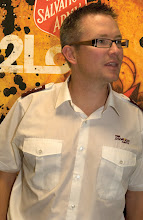a Biblical thought...
One thing I ask of the LORD, this is what I seek: that I may dwell in the house of the LORD all the days of my life, to gaze upon the beauty of the LORD and to seek him in his temple. (Psalm 27:4)
a Book thought...
One of the goals set by Herbert Booth's 'Move-on Manifesto in 1896 was to start Chinese corps in Sydney and Melbourne. (p198)
One thing I ask of the LORD, this is what I seek: that I may dwell in the house of the LORD all the days of my life, to gaze upon the beauty of the LORD and to seek him in his temple. (Psalm 27:4)
a Book thought...
One of the goals set by Herbert Booth's 'Move-on Manifesto in 1896 was to start Chinese corps in Sydney and Melbourne. (p198)
 a Dave thought... by Michael Hyatt
a Dave thought... by Michael HyattIf leaders are going to be effective with the current generation of Internet-savvy web-users, they must shift their leadership style. I call this Leadership 2.0. Here’s how it compares to Leadership 1.0:
Leadership 2.0 embraces change. Like Web 1.0, old-style leadership was fairly static. Leaders resisted change and were more focused on preserving the status quo. However, Leadership 2.0 embraces change. New-style leaders are on the cutting edge of experimentation. If something doesn’t work, they change course quickly. They are more concerned about driving the right outcomes than maintaining business-as-usual.
Leadership 2.0 demonstrates transparency. Old-style leaders were opaque. They wouldn’t tell you anything they didn’t have to tell you. They kept themselves shrouded in mystery. (Think of “Oz.”) New-style leaders are open and transparent. They let you see them for who they are—warts and all. They risk self-disclosure, preferring to acknowledge the truth of who they are rather than pretend to be something they are not.
Leadership 2.0 celebrates dialogue. Old-style leaders delivered a monologue. They did all the talking. The fact that they were the boss was proof enough that they were smarter than everyone else n the room. New-style leaders listen more than they talk. They ask questions. They lead powerful conversations. Why? Because they know that “all of us are smarter than some of us” to quote James Surowiecki in The Wisdom of Crowds.
Leadership 2.0 employs collaboration. Old-style leaders were competitive. They held all the cards close to their vest. They didn’t “play well with others.” They refused to help anyone they perceived as the competition, even if they were theoretically on the same team. New-style leaders are all about teamwork. They are inclusive in the way they lead, drawing you in and making you feel that you are doing something great—together. They enroll others as “colleagues” and “partners.”
Leadership 2.0 practices sharing. Old-style leaders hoarded their resources—their contacts, their insights, their time, energy and money. They played a zero-sum game. Their didn’t believe they could be generous without depleting their own pile of stuff. New-style leaders are just the opposite. They have an abundance-mentality. They freely share their resources, believing that “there is plenty more where that came from.” They know “it is more blessed to give than to receive” (see Acts 20:35)
Leadership 2.0 welcomes engagement. Old-style leaders were aloof and detached. They didn’t expect to get their hands dirty by actually talking to customers and other constituents. They stood above the fray, dispassionately observing the masses. New-style leaders don’t think in terms of hierarchy, as if something is beneath them. They jump in with both feet, happily and passionately engaging with anyone and everyone.
Leadership 2.0 builds community. Old-style leaders were rugged individualists. They pulled themselves up by their own bootstraps. They didn’t need anyone else. They could do it all themselves, “thank you very much.” New-style leaders, on the other hand, enjoy working with others and building a sustainable community that will go on long after they are gone. They get great satisfaction from working together rather than working alone.
Leadership 2.0 represents a quantum leap forward in effectiveness. It enables leaders to connect with their followers in ways that Leadership 1.0 could never do. The irony is that this may not be so new after all. Jesus Himself was this very kind of leader. But that is a post for another day.
Just a thought.







1 comment:
I believe I've met a leader like that - and he's currently leading the Australia Southern Territory.
Post a Comment